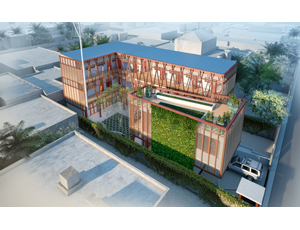
If all goes as planned, the children of Haiti will soon have a small but powerful symbol of hope in the form of a 6,000-sq-ft building. Thanks to the largely volunteer efforts of the U.S. Green Building Council and others, the $1.2-million to $1.5-million William Jefferson Clinton Children's Center of the Fondation Enfant Jesus, which could open by the end of next year, is setting the stage for sustainable, resilient construction in Haiti, which was devastated by a magnitude-7 earthquake on Jan. 12, 2010.
"We really wanted to do something to promote sustainable design that also honors the country's culture and we wanted to empower an existing organization to carry out their mission," says Roger Limoges, vice president of organizational design for the the U.S. Green Building Council and USGBC's project manager for the children's center, which is slated to be built in Port-Au-Prince.
According to Haiti government estimates, the temblor killed 316,000 people, injured 300,000, displaced 1.3 million, destroyed 97,295 houses and damaged 188,383 in the Port-Au-Prince area and in much of southern Haiti, says the U.S. Geological Survey.
The Fondation Enfant Jesus, a nongovernment, nondenominational, apolitical charity, says there are hundreds of thousands of orphans in Haiti. FEJ's Project Haiti, of which the new center is part, provides health care and other services and offers children a pathway to adoption. The new building will replace an FEJ orphanage destroyed by the quake.
The idea for the sustainable center, which will serve 25 to 30 children at a time, belongs to Rick Fedrizzi, the USGBC's president, CEO and founding chairman. At Greenbuild 2010, USGBC announced the project. Last year, it named the center in recognition of the Clinton Global Initiative's work in both sustainability and in Haiti.
Funding is from several sources, including USGBC member companies. Donations of money, sweat equity and materials are welcome.
As designed, the main, three-story structure, which includes living space, is an L in plan with a courtyard. Kitchen and dining areas and a corner stair tower will provide safe spaces during storms. A separate tower contains training and office space. There is also a ground-level safe zone for refuge during an earthquake.
"When designing in a place with so many challenges, can you afford to provide [high-level] design?" says Thomas Knittel, senior principal of design in charge of the project for architect-engineer HOK, which is providing pro bono design services. "We did some soul-searching and decided we could meet basic needs and provide [good architecture]," he adds. "It has been a labor of love.
The center will be Haiti's first LEED-certified orphanage and children's center, says USGBC. The annual net-zero-energy-use design aspires to the highest rating—LEED Platinum—of the USGBC's green building rating system.
The building will be independent of local utilities, which are often unreliable. "When we first started designing, there was no power grid, no water system, no wastewater system," says Mary Ann Lazarus, HOK's sustainable design leader, currently on leave to the American Institute of Architects as an AIA resident fellow.






